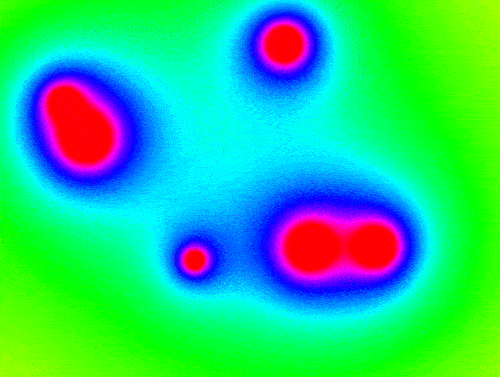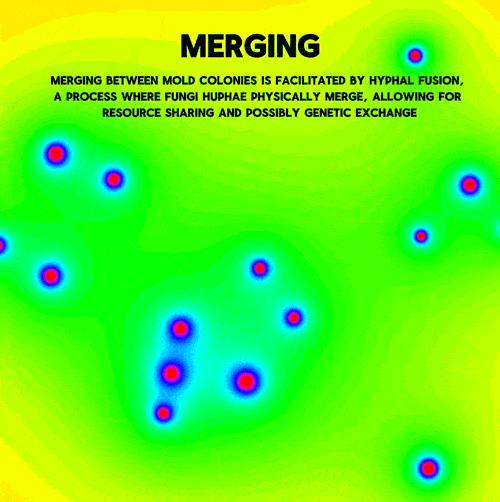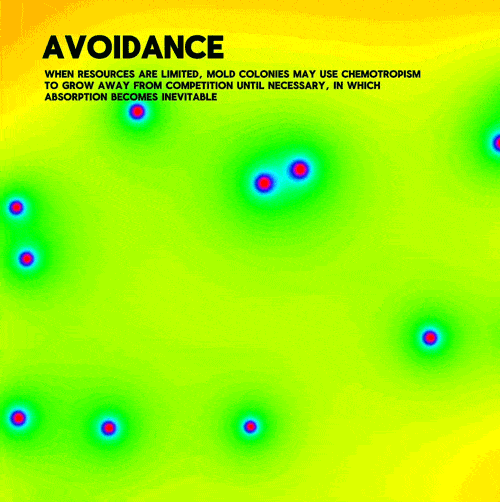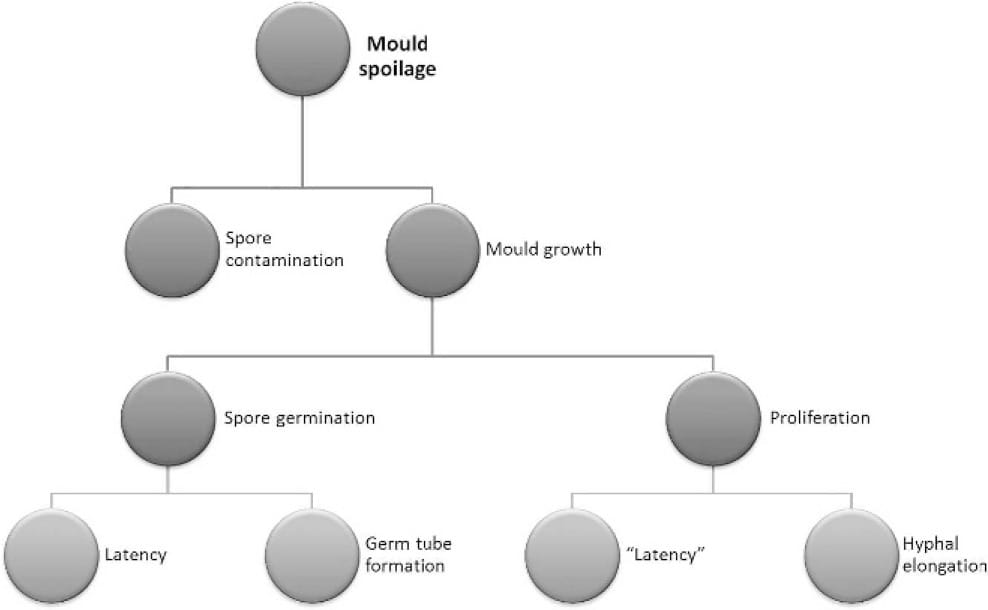Survival Strategies of Mold Colonies

Mold is annoying. No one wants to see fuzzy patch on any of their food.
And yet, it is pretty tight, the fact that so many microbiological processes are happening on such a small scale. Kinda poetic.
This week is a deep dive into mold, and in researching for this blog, I found out about the tactics used for their growth and survival. To my knowledge, they can be loosely summed up into three groups: absorption, merging, and repelling.
Let's dive in, shall we?
I made this interactive version if you want to follow along:
How Does Kōji Mold Behave In Different Environments?
Koji mold, also known as Aspergillus oryzae, is a mold used in East Asia to saccharify things like rice, sweet potato, and some alcoholic beverages such as sake and shōchū.
Simulation of Aspergillus oryzae, aka Kōji Mold
*Each dot represents a mold colonyMold Colony Primer
Molds are a type of fungi and they play a crucial role in nature by breaking down dead organic matter.
A mold colony begins from a few single spores; mold spreads by producing spores, and when spores land on a suitable surface, they can germinate by sending out tiny threads called hyphae. These hyphae can then spread out and intertwine, forming a network known as a mycelium. I went with a gradient-like coloring for the mold colonies in my chart to allude to the fuzzy nature of the mold, but I'm sure the next iteration will be better.
As mold absorbs nutrients of whatever surface its on, the mold colony grows, and it can produce more spores, which can then spread to new areas, continuing the cycle. But there's only so much pie that be shared.
Mold colonies can compete for resources with other microorganisms, including other molds, bacteria, and yeasts. This competition typically involves the ability of different microorganisms - hyphae, in the context of mold - to outcompete others in various 'competitions', such as nutrient uptake, production of enzymes or toxins, growth rates, etc, thus establishing dominance in those areas.
This paper covers quite a lot of the behavior (though of the Ectomycorrhizal Fungi species), and makes a few interesting assertions, such as the fact that competition tends to be asymmetrical, meaning it negatively affects one species but not the other, or that competitive outcomes are usually environmentally context-dependent.
All of that is a bit difficult to simulate in p5.js, to be honest. But it's fun enough to try.
Mold Colony Strategies: Merging for Strength, Avoiding for Space
The behaviors of mold colonies can be seen as the cumulative result of countless microscopic interactions among individual organisms. My goal for this P5 simulation was to mimic simple behaviors that struck the right balance of scientific accuracy and looking cool as shit. The easiest ones to work with were merging and avoidance:
- Merging: this behavior is facilitated by hyphal fusion (anastomosis), a process where the hyphae of fungi physically merge, allowing for resource sharing and possibly genetic exchange. This cooperation is particularly beneficial in environments where resources are plentiful, as it allows individual fungi to form a supercolony that is better equipped to dominate its environment

- Avoidance: In contrast, when resources are limited, molds engage in an avoidance strategy. Molds can detect chemical gradients in their environment (chemotropism) and grow towards or away from certain stimuli, so when resources are limited, molds may grow in directions that minimize competition

- Absorption: Competitive interactions such as parasitism and predation exist among fungi, and involve one organism negatively affecting another. This behavior is underpinned by mechanisms such as mycoparasitism (one fungus parasitizing another), production of inhibitory chemicals that suppress competitors, and the physical overgrowth of one colony over another. Big bank take little bank, truly.

Which foods encourage which strategies?
The strategies of merging and avoidance are also evident in the mold's choice of foods. Now, this was a bit harder to fact-check, so I'm still looking for the links. However, using the logic of the behaviors I explain above, you have a few assumptions that can be made:
Bread
- The abundance of nutrients and the extensive surface area bread offers allow mold colonies to grow uninhibited. When conditions are right—moist, warm —mold colonies on bread will often merge, forming a supercolony.
Cheese
- Cheese presents a fascinating case study in mold behavior due to its variety. Soft cheeses, especially in warm conditions, are like bread in promoting merging behavior. Their high moisture content and rich nutrients provide an ideal setting for mold colonies to coalesce into larger entities.
- Conversely, hard cheeses tell a different story. Their lower moisture content and denser structure make them less hospitable to rapid mold growth. On these cheeses, mold colonies tend to exhibit avoidance behavior, marking clear boundaries to secure their own little domains
Fruits and Vegetables
- Overripe fruits and vegetables, such as strawberries, serve as prime examples of the avoidance strategy in action. As these foods begin to decay, they release nutrients that attract mold. However, the space and resources are often limited. In these scenarios, individual mold colonies opt to keep to themselves, avoiding merging.
Leftovers
- In some cases, molds may start by avoiding each other, staking out territories as they begin to consume the available nutrients. However, as conditions change—perhaps as the food dries out or as one colony exhausts its immediate resources—these same molds may shift tactics, merging to form larger colonies that can more efficiently exploit the remaining nutrients
Concluding Thoughts
It's important that mold behavior is complicated. This, of course, doesn't cover just how much molds are greatly affected by their environment, with gets into climate studies, geography, etc.
There are a few different fields of study for mold colonies that I found, all of which encompass several parts of biology:
- Sporulation: in which researchers study the conditions under which molds decide to sporulate and the various mechanisms through which these spores are spread
- Chemotropism and Phototropism: These terms refer to molds' growth in response to chemical stimuli and light, respectively
- Hyphal Interactions and Mycelial Networks: The way mold hyphae interact with each other and form complex networks is a significant area of study

There even exists evidence of 'cheaters' in the microbiological world.
By understanding mold's behaviors and the conditions under which it thrives, the obvious goal would be to better prevent its spread and keep our food fresher longer. This paper covers some mathematical modeling on how we may be able to predict mold growth, and thus, utilize our tactics in the food safety space.
Aside from that, though, this blog was fun to right because it's something special to remember that every time I throw out a moldy piece of fruit, I'm actually interrupting a microscopic Game of Thrones. Makes me feel like God.